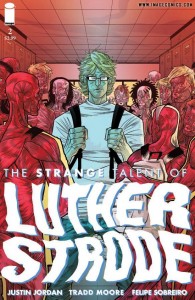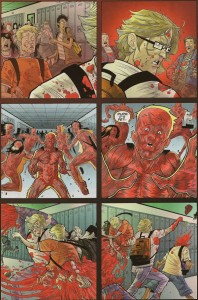 On Friday night, Amanda and I were having a conversation about decompressed storytelling versus old-fashioned serialized storytelling in comics. Because that’s how we roll here at the Crisis On Infinite Midlives Home Office: a little wine, a few lit candles, and deep conversations about the esoterica of comics writing… okay, actually more often it’s shotgunning Buds, arson and screeching, “This book sucks, Lobdell! And that’s why we’re burning down your house!” but we’re trying to expand our horizons.
On Friday night, Amanda and I were having a conversation about decompressed storytelling versus old-fashioned serialized storytelling in comics. Because that’s how we roll here at the Crisis On Infinite Midlives Home Office: a little wine, a few lit candles, and deep conversations about the esoterica of comics writing… okay, actually more often it’s shotgunning Buds, arson and screeching, “This book sucks, Lobdell! And that’s why we’re burning down your house!” but we’re trying to expand our horizons.
Anyway, the agreement we came to is that the problem with decompressed “writing for the trade” is that writers are all-too-willing to make the story beats in each individual issue subtle and slowly-unfolding, to the point where in some of those issues almost nothing seems to happen. Whereas serialized storytelling understands that, yes, there may be a larger story that the individual comics issue is serving, but that the issue should be a story in and of itself, with enough of an arc and satisfying action to be worth owning on its own.
And we wholeheartedly agreed that when it comes to regular comics, we vastly prefer serialized storytelling… And further, we agreed that we should leave poor Scott Lobdell alone… at least while Rob Liefeld’s walking around a home that isn’t primarily comprised of cinders and regret.
The one exception to all rules that we agreed existed was the self-contained miniseries. In the spirit of the old “Lady, you knew I was a snake when you picked me up” parable, a miniseries almost by nature must be told in a decompressed manner, because on its face each issue is part of a larger story. It is what it is, and whether you like decompressed storytelling or not, you know what you’re getting with an issue marked, say, “2 of 6”. And then, because we were feeling generous, we gave Liefeld an exception of his own. Mostly because we found we were out of kerosene. But I’m digressing again, which is stupid because there actually is a point to all this yammering.
That point is that The Strange Talent of Luther Strode #2, despite being part of a self-contained miniseries, meets all the needs of a good serialized story, and a damn good one at that.
Go pick up a comic. Almost any comic will do, particularly one by Marvel. Check out the first page. There’s almost a 100 percent chance that it’s a text-based recap page, telling you in bald print what happened prior to this issue. They do this because they know damn well that they’re going decompressed, and unless you have all the prior issues in the arc, you will have no fucking clue as to what’s going on. It’s like reading a book report by a third grader – all recap, no analysis – and it’s forcing you to read a block of text. If that was something you felt like doing, I’m guessing you wouldn’t be reading a fucking comic book.
This is a crutch that new writer Justin Jordan could easily prop himself up with – after all, Luther Strode is Jordan’s first published comic. Instead, we get a ten-page sequence that shows us Strode returning to high school and getting into a fight. Throughout the course of that sequence, we learn that Strode was suspended for six weeks for tuning up a guy, that he has some kind of ability for extreme violence that he is struggling with and that this is a new development in his life. We’re reintroduced to his wisecracking best friend and his confident and forward potential love interest, and see some excellent, exciting action. We are brought up to speed not with a string of text, but with a string of intestines, and it happens without a single fucking word of extraneous exposition. Shit, even Melville had to chuck in a “Call me Ishmael” now and again, and he didn’t even have the stones to show Ahab yanking someone’s testicles off of their spinal cord.
And part of how we’re brought back into the story is through Tradd Moore’s pencils. In my review of the first issue, I commented that his style is kinda schizophrenic, looping between cartoony and ultra-violent, and that continues here. But Jordan relies on Moore to show us, not tell us, the nature of Luther’s power and what it could mean to the people around him, which he does more than effectively in just a few panels…
 …now that is well-returned confidence in your artist. I don’t know if Moore’s style would work on every book in the world – the best way I can describe it is that it’s kinda like Scott Pilgrim Vs. The World Vs. Leatherface – but the only other artist I could imagine working on this book is maybe Steve Dillon. This is a perfect artistic match, as far as I’m concerned.
…now that is well-returned confidence in your artist. I don’t know if Moore’s style would work on every book in the world – the best way I can describe it is that it’s kinda like Scott Pilgrim Vs. The World Vs. Leatherface – but the only other artist I could imagine working on this book is maybe Steve Dillon. This is a perfect artistic match, as far as I’m concerned.
Everything seems to be coming together in this book. I noted in the first issue that the groundwork was being laid for an old-school 80’s slasher flick, and that setup is already bearing fruit. We have a psycho killing in a suburban house involving a jock, and we’ve already met a wisecracking, sex-obsessed sidekick and a sexually-forward teenaged girl. Like an old friend used to tell me: we’re only a shotgun and a wedding dress away from a zombie attack – or in this case, single-minded murderous psycho attack… and if I had to hazard a guess, I’d say that since Luther’s the only killing machine in a dehumanizing mask we’ve seen, I’m thinking Luther never gets it on with the aggressive chick. Because getting laid means you die in the slasher flicks, and I’m guessing we’re not gonna see Luther yank his own testicles off his spinal cord. At least not any more frequently than any other high school boy.
Normally, for just about any miniseries, I’d recommend waiting for the trade. But in this case, the only reason to do so would be because your local comic store is out of copies. Go pick it up. This book is firing on all cylinders. Which reminds me: I need to buy more kerosene. After all, Red Hood and Hawk & Dove #3 both come out soon.
 Podcast RSS Feed
Podcast RSS Feed iTunes
iTunes Google Play
Google Play Stitcher
Stitcher TuneIn Radio
TuneIn Radio Android
Android Miro Media Player
Miro Media Player Comics Podcast Network
Comics Podcast Network